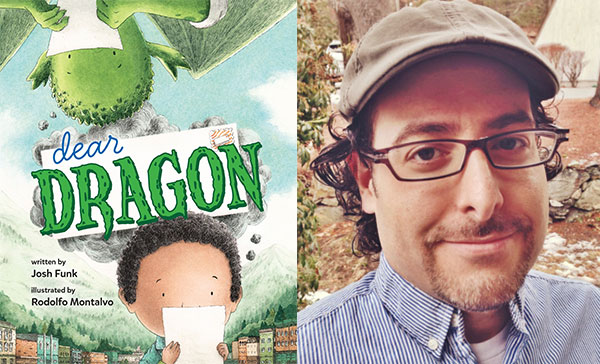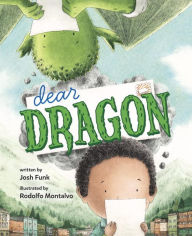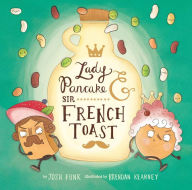Dragon in the Mirror: A Guest Post by Dear Dragon Author Josh Funk

Josh Funk is the author of the delicious modern classic Lady Pancake & Sir French Toast, and the delightful dinosaur/pirate mashup Pirasaurs!. His newest picture book, Dear Dragon, tells the story of two very different pen pals who discover that friendship transcends their differences. Josh was kind enough to share the story behind this inventive tale with The B&N Kids’ Blog.
Dear Dragon: A Pen Pal Tale
Dear Dragon: A Pen Pal Tale
By
Josh Funk
Illustrator
Rodolfo Montalvo
In Stock Online
Hardcover $16.99
I checked the mirrors, looked out the window, and drove off. As my family departed from a Friday morning performance of Charlotte’s Web at the North Shore Music Theatre, my life was consumed by the following:
- My son was experiencing a serious dragon phase.
- My wife’s 8th grade social studies class had pen pals across the world.
- Like many beginning picture book writers, I wrote mostly in rhyme.
Perhaps I was (metaphorically) bitten by a literate spider during that one-act show. So on the car ride to lunch, I decided to write a new picture book by mixing rhyme & poetry along with letter writing. And why not make one of the letter-writers a human (named George) and the other a dragon (named Blaise)? In an effort to add a little humor, I wrote it so that neither character knew he was writing to a different species. George thought he was writing to a human. Blaise thought he was writing to a dragon.
I checked the mirrors, looked out the window, and drove off. As my family departed from a Friday morning performance of Charlotte’s Web at the North Shore Music Theatre, my life was consumed by the following:
- My son was experiencing a serious dragon phase.
- My wife’s 8th grade social studies class had pen pals across the world.
- Like many beginning picture book writers, I wrote mostly in rhyme.
Perhaps I was (metaphorically) bitten by a literate spider during that one-act show. So on the car ride to lunch, I decided to write a new picture book by mixing rhyme & poetry along with letter writing. And why not make one of the letter-writers a human (named George) and the other a dragon (named Blaise)? In an effort to add a little humor, I wrote it so that neither character knew he was writing to a different species. George thought he was writing to a human. Blaise thought he was writing to a dragon.
Lady Pancake & Sir French Toast
Lady Pancake & Sir French Toast
By
Josh Funk
Illustrator
Brendan Kearney
In Stock Online
Hardcover $18.99
When I submitted this story to agents and publishers, I had three hooks: Dragons and letters and poetry! A winning trifecta of a combination. Kids love dragons! And it would work in schools on multiple levels! Poetry units. Perhaps students would rediscover the lost art-form of letter-writing? Maybe teachers would find classrooms around the world with which they could become pen pals!
But then a funny thing happened—something I didn’t expect. The acquiring editor at Viking/Penguin really loved that Dear Dragon was about characters with completely different backgrounds from wholly different cultures that were entirely different species who (spoiler alert) become friends. Without ever having met. All they knew were each other’s words.
When I submitted this story to agents and publishers, I had three hooks: Dragons and letters and poetry! A winning trifecta of a combination. Kids love dragons! And it would work in schools on multiple levels! Poetry units. Perhaps students would rediscover the lost art-form of letter-writing? Maybe teachers would find classrooms around the world with which they could become pen pals!
But then a funny thing happened—something I didn’t expect. The acquiring editor at Viking/Penguin really loved that Dear Dragon was about characters with completely different backgrounds from wholly different cultures that were entirely different species who (spoiler alert) become friends. Without ever having met. All they knew were each other’s words.
Pirasaurs!
Pirasaurs!
By
Josh Funk
Illustrator
Michael H. Slack
Hardcover $14.99
I didn’t intend to write a book about friendship overcoming differences, but that was what an editor saw when looking at the text.
And my editor wasn’t alone. More and more people, particularly educators, have made similar comments to me, especially in light of events in the news. They were really excited about how they could use Dear Dragon to discuss making character assumptions.
In school, kids learn that reading can be a mirror into one’s own world. When I read Dear Dragon, I see a humorous book about poetry, dragons, and letter-writing. My editor sees a book about friendship overcoming differences. And educators identify a book they can use in classrooms to talk about making assumptions.
When George reads a letter from Blaise about his favorite sport being skydiving, he imagines a boy skydiving. When Blaise reads George’s letter about winning the science fair with a volcano, he pictures a dragon flying around a real volcano.
But reading can also be a window—a perspective into another’s world. And each spread of Dear Dragon shows both a mirror AND a window.
The reader gets to see George’s mirror of a skydiving child, as well as the window into Blaise’s world.
The reader gets to see Blaise’s mirror of a dragon at a volcano, as well as the window into George’s science fair.
My goal as a writer has always been to entertain. On the surface, Dear Dragon is a book about dragons and letters and poetry—and hopefully an enjoyable read. But the best books are the ones that live on in the mind of readers, well after the story ends. They connect deep within us, but also allow us to feel things we otherwise wouldn’t and see things we otherwise couldn’t.
And this is the great thing about reading. It can open a child’s heart and mind. It engages the imagination. George and Blaise (literally and figuratively) imagine themselves in each other’s shoes (or lack of shoes, as dragons don’t need footwear). Reading has been proven to build empathy. It takes practice to see the world from another’s perspective.
Regardless of what we look like, where we live, or what we do for a living—we’re all human (or dragons) with the potential to be friends. The more we read, the better we’ll know both ourselves and others. So before you drive off into a new book, make sure to check your mirrors and windows.
Dear Dragon is on shelves September 6.
I didn’t intend to write a book about friendship overcoming differences, but that was what an editor saw when looking at the text.
And my editor wasn’t alone. More and more people, particularly educators, have made similar comments to me, especially in light of events in the news. They were really excited about how they could use Dear Dragon to discuss making character assumptions.
In school, kids learn that reading can be a mirror into one’s own world. When I read Dear Dragon, I see a humorous book about poetry, dragons, and letter-writing. My editor sees a book about friendship overcoming differences. And educators identify a book they can use in classrooms to talk about making assumptions.
When George reads a letter from Blaise about his favorite sport being skydiving, he imagines a boy skydiving. When Blaise reads George’s letter about winning the science fair with a volcano, he pictures a dragon flying around a real volcano.
But reading can also be a window—a perspective into another’s world. And each spread of Dear Dragon shows both a mirror AND a window.
The reader gets to see George’s mirror of a skydiving child, as well as the window into Blaise’s world.
The reader gets to see Blaise’s mirror of a dragon at a volcano, as well as the window into George’s science fair.
My goal as a writer has always been to entertain. On the surface, Dear Dragon is a book about dragons and letters and poetry—and hopefully an enjoyable read. But the best books are the ones that live on in the mind of readers, well after the story ends. They connect deep within us, but also allow us to feel things we otherwise wouldn’t and see things we otherwise couldn’t.
And this is the great thing about reading. It can open a child’s heart and mind. It engages the imagination. George and Blaise (literally and figuratively) imagine themselves in each other’s shoes (or lack of shoes, as dragons don’t need footwear). Reading has been proven to build empathy. It takes practice to see the world from another’s perspective.
Regardless of what we look like, where we live, or what we do for a living—we’re all human (or dragons) with the potential to be friends. The more we read, the better we’ll know both ourselves and others. So before you drive off into a new book, make sure to check your mirrors and windows.
Dear Dragon is on shelves September 6.


